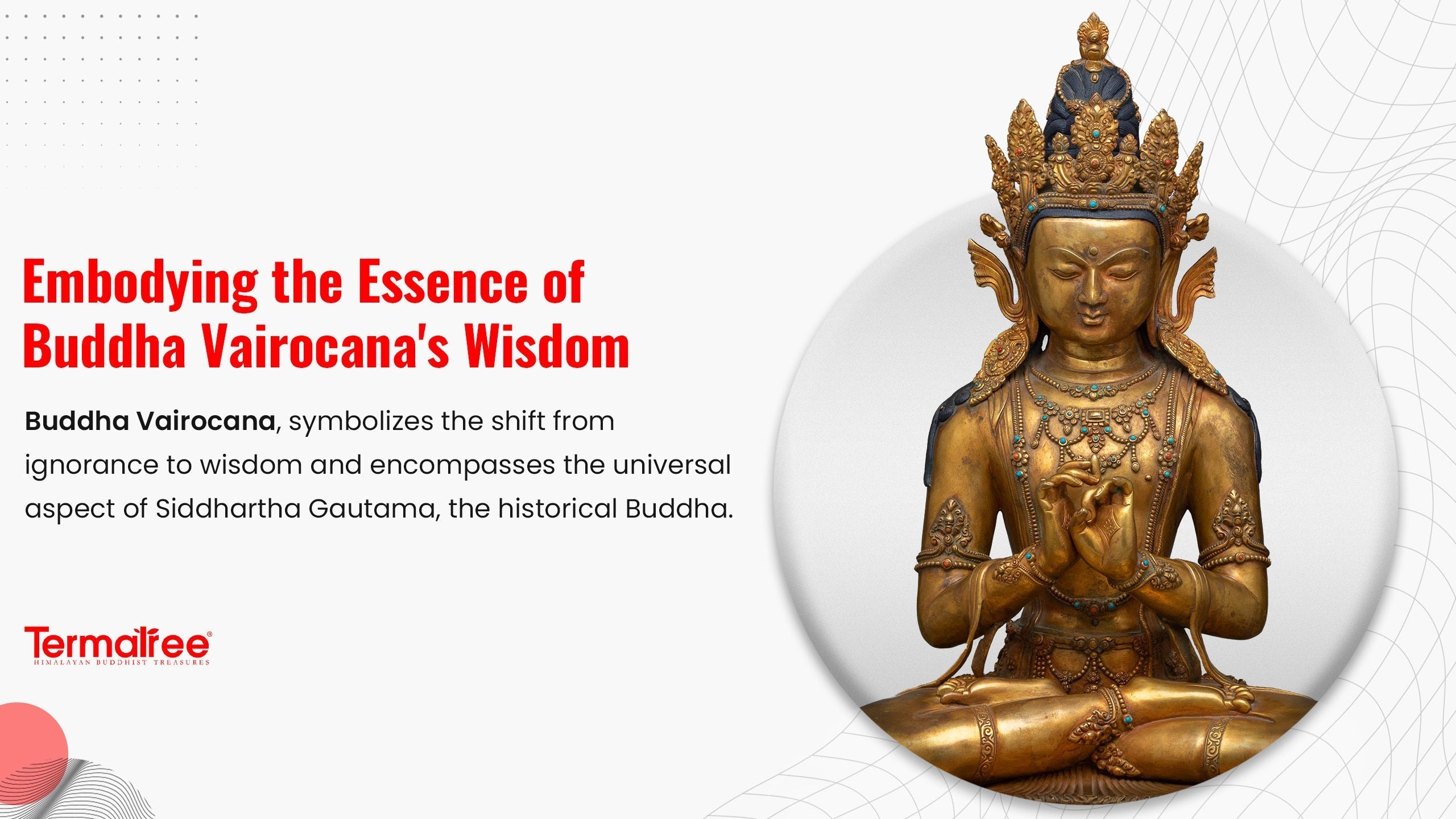Buddha Vairocana: Exploring the Cosmic Buddha
Buddha Vairocana, known as the "Cosmic Buddha," is pivotal in Mahayana and Vajrayana Buddhism, embodying the essence of sunyata, or emptiness. Often called the "Illuminator" or "He Who is Like the Sun," this mysterious deity symbolizes the shift from ignorance to wisdom and encompasses the universal aspect of Siddhartha Gautama, the historical Buddha.
Key Takeaways:
- Buddha Vairocana is a pivotal figure in Mahayana and Vajrayana Buddhism.
- He represents the transformation of ignorance into wisdom and universal enlightenment.
- Vairocana's iconography and symbolism are rich and varied across Buddhist traditions.
- Understanding Vairocana's teachings and representations deepens the comprehension of Buddhist philosophy and practice.
Buddha Vairocana transcends mere deity status within the Buddhist pantheon, becoming a potent symbol that encapsulates Buddhism's deep mysteries and teachings.
Grasping the essence of Vairocana leads one to the core of Buddhist philosophy, unraveling themes of enlightenment, emptiness, and the very fabric of reality. This journey unveils not just the historical and cultural importance of Vairocana but also provides profound insights into Buddhism's varied practices and interpretations across different regions.
Historical and Cultural Context

Click here to view Buddha Vairocana Statue
Origins and Development
- Early references: Buddha Vairocana emerges in early Mahayana sutras such as the Avatamsaka Sutra, underscoring his initial importance in Buddhist thought.
- Cultural influence: The concept of Buddha Vairocana thrived in India during the initial centuries CE before extending its power to various regions across Asia.
Scholars assert that Vairocana debuted in the Mahayana Brahmajala (Brahma Net) Sutra, believed to have originated in China in the early 5th century CE. Described as "one who comes from the sun" in Sanskrit, Vairocana is portrayed seated on a regal lion's throne, emitting radiant light as he addresses a congregation of Buddhas.
Moreover, Vairocana holds significance in the Avatamsaka (Flower Garland) Sutra, a comprehensive text authored by multiple individuals. While the initial segment was completed in the 5th century, subsequent additions could stretch into the 8th century.
Spread Across Asia
- China and Japan: Vairocana was central in prominent Buddhist schools such as Tiantai and Shingon.
- Tibet: Vairocana holds a pivotal position in tantric practices and iconography within Tibetan Buddhism.
Iconography and Symbolism
Physical Representation
- Posture and Gestures: Frequently portrayed in the dharma chakra mudra, symbolizing the turning of the Wheel of Dharma.
- Facial Expression: Radiating serenity, his face embodies the state of supreme enlightenment.
Symbolic Elements
- Lotus Throne: Symbolizing purity and the enlightened mind.
- Sun Halo: Represents his illuminating presence and cosmic significance.
| Element | Symbolic Meaning |
| Mudra | Teaching & Wisdom |
| Halo | Divine radiance & Knowledge |
| Throne | Elevated spiritual status |
Symbolism of the Deity
Dharmadhatu Wisdom stands as a fundamental concept in Buddhist philosophy, symbolizing the interconnectedness of all phenomena. Embodying this wisdom, Vairocana Buddha enables individuals to transcend their personal experiences, gaining a deeper understanding of the unifying principle that binds everything together.
Referred to as the Cosmic Buddha, Vairocana is often depicted as a celestial being transcending the physical realm, enveloping the cosmos in brilliance. This portrayal encourages people to elevate themselves beyond the mundane, connecting with the cosmic forces that permeate the universe and fostering harmonious coexistence.
In the realm of the Pancha Buddhas, Vairochana Buddha, also known as Namnang in Tibetan Buddhism, holds the highest position. As the Primordial Buddha, Vairochana embodies the profound wisdom of Sunyata and manifests the essence of Dharma realm meditation mudra.
Vairocana in Different Buddhist Traditions

Vairocana In Tibetan Buddhism
- Role in Tantra: Integral to numerous tantric practices and visualizations, Vairocana is frequently featured in mandalas and thangkas.
- Symbolism: Epitomizing the unity of all Buddhas and the essence of transcendent wisdom.
East Asian Buddhism
- China: Central to the Tiantai and Huayan schools, Vairocana's teachings underscore the interconnectedness and non-duality of all phenomena.
- Japan: Within Shingon Buddhism, Vairocana is revered as the embodiment of the Dharma and the principle of Dharma transmission.
Vairocana Buddha Mantra
"Om Vairocana Om"
Reciting the Vairocana mantra is believed to purify the mind and body from pollutants, promoting inner tranquility and mental clarity. This practice contributes to the spiritual journey by eliminating barriers and transforming negative energy into positive forces, facilitating progress.
Regular mantra recitation enhances knowledge and insight, enabling individuals to perceive reality more clearly. The potential benefits extend to physical and mental realms, fostering healing and contributing to overall life balance and well-being.
Teachings and Philosophy
Sunyata (Emptiness)
- Concept: The doctrine of sunyata challenges conventional notions of existence by asserting that all phenomena lack inherent existence.
- Philosophical Significance: This concept is pivotal for comprehending the nature of reality in Mahayana Buddhism.
Buddha Nature
- Universal Enlightenment: Vairocana symbolizes all beings' inherent potential for enlightenment.
- Inherent Wisdom: His teachings highlight the existence of Buddha nature, even in states of ignorance or delusion.
Buddha Vairocana, embodying cosmic awareness and universal enlightenment, provides profound insights into the core of Buddhist thought and practice. His teachings, transcending cultural and temporal boundaries, persistently inspire and guide practitioners toward a path of wisdom and compassion. Vairocana's enduring legacy, woven with symbolism and philosophy, stands as a beacon of enlightenment within the intricate tapestry of Buddhist traditions.




